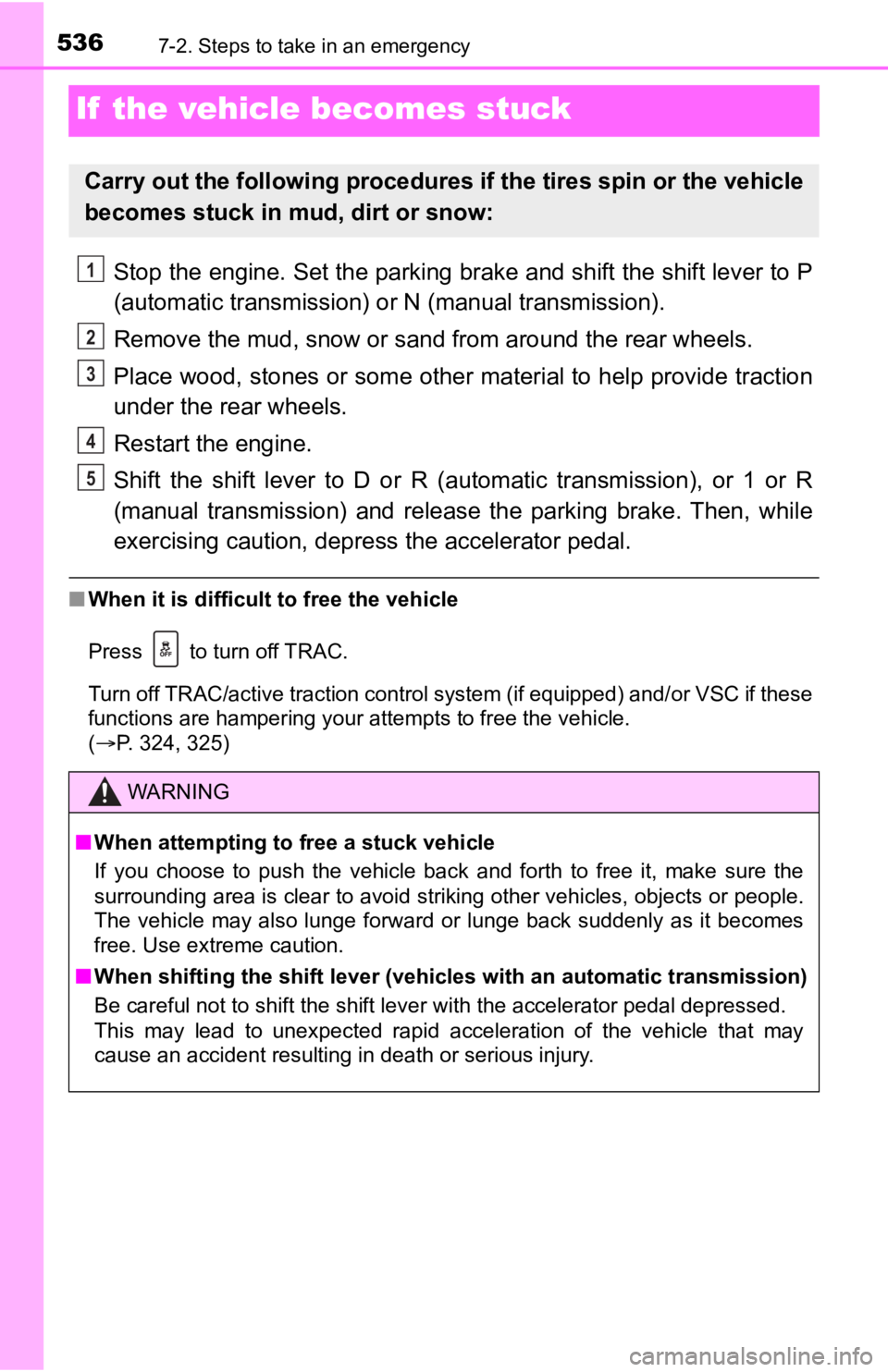Page 513 of 616

5137-2. Steps to take in an emergency
7
When trouble arises
WARNING
■Using the tire jack
Observe the following precautions.
Improper use of the tire jack may cause the vehicle to suddenly fall off
the jack, leading to death or serious injury.
●Do not use the tire jack for any purpose other than replacing t ires or
installing and removing tire chains.
●Only use the tire jack that comes with this vehicle for replacing a flat
tire.
Do not use it on other vehicles, and do not use other tire jacks for
replacing tires on this vehicle.
●Put the jack properl y in its jack point.
●Do not put any part of your body under the vehicle while it is supported
by the jack.
●Do not start the engine or drive the vehicle while the vehicle is sup-
ported by the jack.
●Do not raise the vehicle w hile someone is inside.
●When raising the vehicle, do not put an object on or under the jack.
●Do not raise the vehicle to a height greater than that required to
replace the tire.
●Use a jack stand if it is necessary to get under the vehicle.
●When lowering the vehicle, make sure that there is no-one near the
vehicle. If there are people nearby, warn them vocally before l owering.
■Using the jack handle
Insert the square head securely until you hear a click to prevent the
extension parts from coming apart unexpectedly.
Page 517 of 616
5177-2. Steps to take in an emergency
7
When trouble arises
Chock the tires.
Slightly loosen the wheel nuts
(one turn).
Assemble the jack handle
extension as shown.
Replacing a flat tire
1
Flat tireWheel chock positions
FrontLeft-hand sideBehind the rear right-hand side tire
Right-hand sideBehind the rear left-hand side tire
RearLeft-hand sideIn front of the front right-hand side tire
Right-hand sideIn front of the front left-hand side tire
2
3
Page 523 of 616

5237-2. Steps to take in an emergency
7
When trouble arises
■The temporary spare tire
●Your vehicle is equipped with a temporary spare tire that may be a differ-
ent size, tread type, and/or manufacturer from the ground tires installed
on your vehicle.
●The temporary spare tire is iden tified by the “TEMPORARY USE ON LY ”
marking on the disc wheel and/or the tire sidewall.
Use the temporary spare tire temp orarily, and only in an emergency.
●Make sure to check the tire inflation pressure of the temporary spare
tire. ( P. 5 5 1 )
■After completing the tire change (vehicles with the tire pressu re
warning system)
The tire pressure warni ng system must be reset. ( P. 433)
■When using the temporary spare tire (vehicles with the tire pre ssure
warning system)
As the temporary spare tire is no t equipped with the tire pressure warning
valve and transmitter, low inflation pressure of the spare tire will not be
indicated by the tire pressure warning system. Also, if you rep lace the
temporary spare tire after the tire pressure warning light come s on, the
light remains on.
■If you have a flat rear tire on a road covered with snow or ice
Install the temporary spare tire on one of the front wheels of the vehicle.
Perform the following steps and f it tire chains to the rear tires:
Replace a front tire with the temporary spare tire.
Replace the flat rear tire with the tire removed from the front of the
vehicle.
Fit tire chains to the rear tires.
1
2
3
Page 524 of 616

5247-2. Steps to take in an emergency
WARNING
■When using the temporary spare tire
●Remember that the temporary spare tire provided is specifically
designed for use with your vehicle. Do not use your temporary spare
tire on another vehicle.
●Do not use more than one temporary spare tires simultaneously.
●Replace the temporary spare tire with a standard tire as soon a s possi-
ble.
●Avoid sudden acceleration, abrupt steering, sudden braking and shift-
ing operations that cause sudden engine braking.
■When the spare tire is attached
The vehicle speed may not be co rrectly detected, and the following sys-
tems may not operate correctly:
Also, not only can the following system not be utilized fully, but it may
even negatively affect the drive-train components:
• 4WD system
■Speed limit when using th e temporary spare tire
Do not drive at speeds in excess of 50 mph (80 km/h) when a temporary
spare tire is installed on the vehicle.
The temporary spare tire is not designed for driving at high sp eeds. Fail-
ure to observe this precaution may lead to an accident causing death or
serious injury.
• ABS & Brake assist
• VSC
• TRC
• AUTO LSD
• Dynamic radar cruise control
(if equipped)
• Pre-Collision System (if equipped)
• Automatic High Beam (if equipped)
• LDA (Lane Departure Alert) (if
equipped)
• Hill-start assist control
(if equipped)
• Cruise control (if equipped)
• Active traction control system (if equipped)
• Multi Terrain ABS (if equipped)
• Multi-terrain Select (if equipped)
• Crawl Control (if equipped)
• Navigation system (if equipped)
Page 525 of 616

5257-2. Steps to take in an emergency
7
When trouble arises
NOTICE
■Do not drive the vehicle with a flat tire
Do not continue driving with a flat tire.
Driving even a short distance with a flat tire can damage the tire and the
wheel beyond repair.
■Driving with tire chains a nd the temporary spare tire
Do not fit tire chains to t he temporary spare tire.
Tire chains may damage the vehicle body and adversely affect dr iving
performance.
■When replacing the tires (vehicles with the tire pressure warning
system)
When removing or fitting the wheels, tires or the tire pressure warning
valve and transmitter, contact your Toyota dealer as the tire p ressure
warning valve and transmitter may be damaged if not handled correctly.
■To avoid damage to the tire pressure warning valves and transmi t-
ters (if equipped)
When a tire is repaired with liquid sealants, the tire pressure warning valve and transmitter may not operate properly. If a liquid sea lant is
used, contact your Toyota dealer or other qualified service shop as soon
as possible. Make sure to replace the tire pressure warning valve and
transmitter when replacing the tire. ( P. 432)
Page 536 of 616

5367-2. Steps to take in an emergency
If the vehicle becomes stuck
Stop the engine. Set the parking brake and shift the shift lever to P
(automatic transmission) or N (manual transmission).
Remove the mud, snow or sand from around the rear wheels.
Place wood, stones or some other material to help provide traction
under the rear wheels.
Restart the engine.
Shift the shift lever to D or R (automatic transmission), or 1 or R
(manual transmission) and release the parking brake. Then, whil e
exercising caution, depress the accelerator pedal.
■ When it is difficult to free the vehicle
Press to turn off TRAC.
Turn off TRAC/active traction control system (if equipped) and/or VSC if these
functions are hampering your attempts to free the vehicle.
(P. 324, 325)
Carry out the following procedures if the tires spin or the vehicle
becomes stuck in mud, dirt or snow:
WARNING
■ When attempting to f ree a stuck vehicle
If you choose to push the vehicle back and forth to free it, make sure the
surrounding area is clear to avoid striking other vehicles, obj ects or people.
The vehicle may also lunge forward or lunge back suddenly as it becomes
free. Use extreme caution.
■ When shifting the shift lever (vehicles with an automatic trans mission)
Be careful not to shift the shift lever with the accelerator pedal depressed.
This may lead to unexpected rapid acceleration of the vehicle t hat may
cause an accident resulting in death or serious injury.
1
2
3
4
5
Page 540 of 616
5408-1. Specifications
Maintenance data (fuel, oil level, etc.)
*1: Unladen vehicle
*2: P265/60R18 tires
*3: Vehicles with a over fender
■
TWR (Trailer Weight Rating)
P. 1 8 7
Dimensions
Cab type Access Cab
Overall length212.3 in. (5392.3 mm)
Overall width 74.4 in. (1890.5 mm)
Overall height*170.6 in. (1792.2 mm)
Wheelbase127.8 in. (3247 mm)
Front tread63.0 in. (1599 mm)
63.3 in. (1609 mm)*2
Rear tread63.2 in. (1606 mm)
63.6 in. (1616 mm)*2
Cab typeDouble Cab
With short deck With long deck
Overall length
212.3 in. (5392.3 mm) 225.5 in. (5727.3 mm)
Overall width74.4 in. (1890.5 mm)
75.2 in. (1910.3 mm)*3
Overall height*170.6 in. (1792.2 mm)
Wheelbase
127.8 in. (3247 mm) 141.0 in. (3582 mm)
Front tread63.0 in. (1599 mm)
63.3 in. (1609 mm)*2
Rear tread63.2 in. (1606 mm)
63.6 in. (1616 mm)*2
Page 551 of 616
5518-1. Specifications
8
Vehicle specifications
Ty p e A
Ty p e B
Tires and wheels
Tire sizeP245/75R16 109S
Tire inflation pressure
(Recommended cold
tire inflation pressure)
Front tires:
32 psi (220 kPa, 2.2 kgf/cm2 or bar)
Rear tires:
32 psi (220 kPa, 2.2 kgf/cm
2 or bar)
Spare tire:
32 psi (220 kPa, 2.2 kgf/cm
2 or bar)
Wheel size16 × 7 J, 16 × 7 JJ (spare wheel)
Wheel nut torque83 ft·lbf (113 N·m, 11.5 kgf·m)
Tire size265/70R16 112T
Tire inflation pressure
(Recommended cold
tire inflation pressure)
Front tires:
30 psi (210 kPa, 2.1 kgf/cm2 or bar)
Rear tires:
30 psi (210 kPa, 2.1 kgf/cm
2 or bar)
Spare tire:
30 psi (210 kPa, 2.1 kgf/cm
2 or bar)
Wheel size16 × 7 J, 16 × 7 JJ (spare wheel)
Wheel nut torque83 ft·lbf (113 N·m, 11.5 kgf·m)